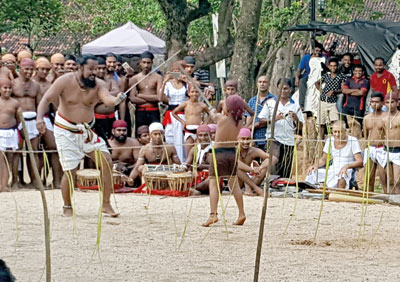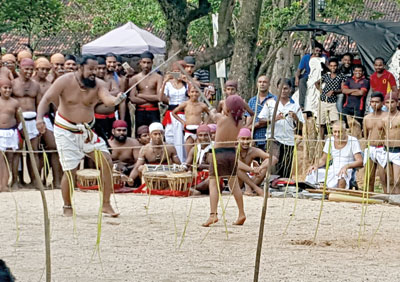Arts
An ancient combat that has relevance today
“You might look tall and well built but that has no bearing on on your ability to fight,” teased Vageesha Bandara, an Angampora master, addressing a group of his students who had just finished a combat sequence. Vageesha’s students were showcasing their talent and studies of the traditional Sinhala martial art, Angampora, at the Janakala Kendraya (or Ape Gama as it is otherwise known) for a celebratory event on August 26.
During the combat sequence, the student with the most impressive physique and stature had fumbled considerably. Vageesha did not hesitate to point this out. He then called on one of the youngest, frailest-looking students to repeat the fight sequence. The boy, barely over four feet tall, began immediately, alone in the middle of 300 or more spectators. Vageesha drew the crowd’s attention to the perfect form and strength in the child’s movement.
Angampora literally means ‘hand combat’. It is a traditional martial art form practised by the Sinhalese. “The techniques of this indigenous combat performance rely on the strength of human body incorporating shots, punches, locks, jumps, and wrestling elements,” says MudithaAnkumbura, a cultural heritage specialist. “Yoga and meditation are also fundamental parts of angam. Angam fighters require elevated physical strength and flexibility as well as mental strength to channel spiritual power.”
Interestingly, Vageesha Bandara has also been one of the trainers of the Sri Lankan women’s cricket team, teaching them yoga and meditation techniques of angam fighters. Vice-captain of the national team, Chamari Atapattu recently made headlines with her batting performance against the Australian team. Sports journalist Geoff Lemon called it ‘one of the greatest things I’ve seen live on a cricket field. Virat Kohli in Adelaide or Asad Shafiq in Brisbane, the Champions Trophy for Pakistan…This sort of company.” Atapattu and her team trained with Vageesha Bandara for three months. “They learn meditation and control of the mind in order to judge what the bowler will do,” explained Vageesha.
The Angampora students displayed a wide array of skills, from bare-handed combat to using weapons. Some weapons were everyday tools that villagers of yore would have had easy access to, such as threshing sticks, paddy scythes and dry reeds. They also used weapons, including single-edged swords, poles and a particularly malevolent-looking whip which had three long metal prongs each with jagged edges. Above all, their mastery of yoga stood out. From the thin to the stocky, young and the old, all the fighters displayed admirable physical strength, flexibility and control through their movements through yoga asanas.
The oldest was a 70-something vedamahattaya, Bunty, who also performed combat sequences, both barehanded and with a pole. The youngest was Vageesha’s own son. Barely up to his father’s hips, the little one challenged his father to an impressive sword fight. It was a fine symbol of the continuing transmission of traditional cultural knowledge from generation to generation.
The celebration of angampora took place at Janakala Kendraya with the support of the Arts Council of Sri Lanka.

